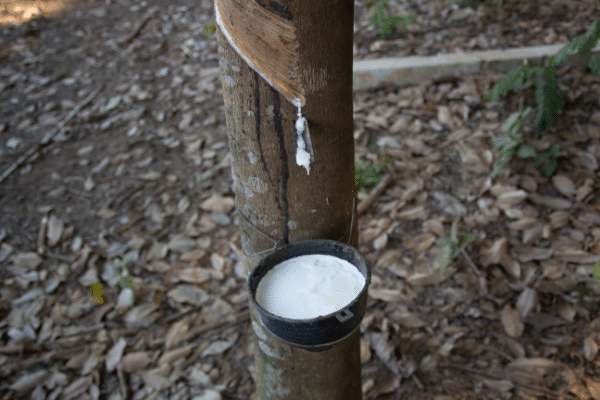Elastomers are polymers that fulfill a specific function in different industrial uses, thanks to their elastic properties. In this article we explain what elastomers are, their characteristics, the different types that exist and their applications.
What are elastomers?
Elastomers are highly elastic and viscous polymers formed by long molecules in the form of long carbon, hydrogen, oxygen or silicon chains, whose chemical structures have intermolecular cross-links and are capable of recovering their original shape after being stretched.
Under normal conditions, the long molecules that make up the material are irregularly coiled. However, when a force is applied, the molecules straighten in the direction in which they are pulled. When released, the molecules spontaneously return to their normal, compact and random arrangement.
Elastomers are slightly cross-linked and amorphous, have extremely weak intermolecular forces, a low Young’s modulus and a glass transition temperature below room temperature.
They are characterized as a viscoelastic material, which means that they have both elasticity and viscosity. In addition, they have a high failure/yield stress. However, most elastomers are thermosetting and require curing by heat, irradiation or chemical reaction.
The elastomer that has been in use the longest is polyisoprene, the polymer that makes up natural rubber and is manufactured from latex, the milky sap of various plants, especially the Hevea tree. Its name comes from the indigenous word caoutchouc, meaning “weeping tree”. It is documented that the ancient Mesoamerican civilizations already knew rubber and used it to make balls and shoe soles. Today, it is still an important industrial polymer, although it now competes with other synthetic materials, such as styrene-butadiene rubber and butadiene rubber, derived from petroleum and natural gas by-products.

Types of elastomers
We can divide elastomers into two categories, which are:
Unsaturated
Those elastomers that contain carbon-carbon double or triple bonds. In this case, both sulfur and non-sulfur vulcanization can cure unsaturated elastomers such as polybutadiene, chloroprene rubber, butyl rubber, nitrile rubber or synthetic polyisoprene.
Saturated
This type of elastomers have superior stability against ozone, heat, oxygen and radiation; they only react in a limited number of situations under specific conditions. Some of them are polyacrylic rubber, silicone rubber, polyether block amides or ethylene-vinyl acetate, among others.
Properties of elastomers
The two most characteristic properties of elastomers are viscosity and elasticity. Elastomers are usually very viscous, so they flow slowly under force, and they also exhibit high elasticity, i.e. the ability to return to their original shape after being stretched or compressed under force, making them more resistant to breaking or cracking.
The properties of elastomers depend on the number of polymeric cross-links, their strength and their distribution in the material.
With this in mind, some of the most common particularities are that they are insoluble, can swell in the presence of certain solvents and have low creep resistance. Some elastomers are resistant to heat and environmental conditions such as moisture and steam. Similarly, thermoset elastomers also cannot melt when heated; thermoset elastomers are the most common type of elastomer and usually require a vulcanization process to modify their properties and convert them into quality rubbers.
Vulcanization, discovered in the 19th century by Charles Goodyear, is a process by which sulfur is added to rubber and when heated, it is transformed into an elastic solid in which the molecules become permanently bonded. In addition, the addition of a small amount of sulfur in various forms makes the rubber molecules irregular enough to prevent crystallization and thus hardening at low temperatures. The interlocking process is often referred to as curing or vulcanization, after Vulcan, the Roman god of fire.
On the other hand, thermoplastic elastomers melt when heated because their cross-links are significantly weaker, allowing the material to melt and reform without losing its elastomeric properties. It is, therefore, a type of elastomer commonly used in manufacturing processes, as they are more easily recycled and have greater stretchability than thermoset elastomers.
Industrial applications of elastomers
Elastomers have fundamental uses in all types of industries thanks to their flexible, elastic and insoluble properties, among others. Some of their industrial applications are as follows:
Automotive industry
As a result of their resistance to melting, thermosetting elastomers are used to manufacture tires, certain seals in automotive design or the manufacture of components exposed to heat during operation.
Typical consumer products
Natural rubber shoe soles, neoprene wetsuits, silicone baby pacifiers and elastic clothing are some of the products made from elastomers that are used in everyday life.
Construction
Sealants for filling cracks and voids or adhesives, as well as insulating materials for electrical cables, are made from elastomers.
Petroleum industry
Synthetic elastomers made from petroleum products have a wide variety of applications. These include hydraulic seals used to prevent leaks in oil plants or hoses.
Materials industry
Industrial products and tools often contain elastomers, such as neoprene used in industrial belts, silicone for lubricants or natural rubber applied to seals.
Medicine
Some prostheses that require flexibility, molds, gloves, lubricants and other products that need a high level of thermal resistance are manufactured with elastomers.
3D printing
Many 3D printers use thermoplastic elastomers as the base material for printed products.
If you want to solve any problem you have with elastomeric components, contact our Forensic Engineering team. Contact Infinita, we can help you.

